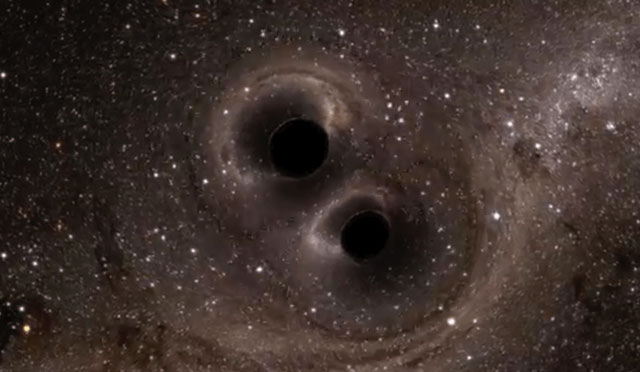
One hundred years ago, Albert Einstein, in his general theory of relativity, predicted the existence of a dark side to the cosmos.
He thought there were invisible “gravitational waves”, ripples in space-time produced by some of the most violent events in the cosmos — exploding stars, colliding black holes, perhaps even the Big Bang itself. For decades, astronomers have gathered strong corroborative evidence of the existence of these waves, but they have never been detected directly — until now. They were the last part of the general theory still to be verified.
Astronomers have used light to study the universe with optical telescopes for hundreds of years. We have expanded that view hugely since the middle of the 20th century, by building detectors and instruments sensitive to all the forms of what physicists mean by light: the electromagnetic spectrum, from gamma rays to radio. Yet the discovery of gravitational waves represents our first steps into studying the universe through the gravitational-wave spectrum, which exists independently from light, probing directly the effects of gravity as it spreads across the cosmos. It is the first page in a whole new chapter for astronomy, and science.
How we made the discovery
The discovery dates back to last September, when two giant measuring devices in different parts of the US called LIGO (Laser Interferometer Gravitational-Wave Observatory) caught a passing gravitational wave from the collision of two massive black holes in a faraway galaxy. LIGO is what we call an interferometer, consisting of two 4km “arms” set at right angles to each other, protected by concrete tubes, and a laser beam which is shone and reflected back and forth by mirrors at each end.
When a gravitational wave passes by, the stretching and squashing of space causes these arms alternately to lengthen and shrink, one getting longer while the other gets shorter and then vice versa. As the arms change lengths, the laser beams take a different time to travel through them. This means that the two beams are no longer “in step” and what we call an interference pattern is produced — hence the name interferometer.
The changes in the length of the arms are actually tiny — roughly one million millionth the width of a human hair. This is because the signal from a gravitational wave from far out in the cosmos is mindbogglingly small by the time it reaches us. As if detecting this were not difficult enough, all manner of local disturbances on Earth make it worse, from the ground shaking to power-grid fluctuations; and instrumental “noises” that could mimic or indeed completely swamp a real signal from the cosmos.
To achieve the astounding sensitivity required, almost every aspect of the LIGO detectors’ design has been upgraded over the past few years. We at the University of Glasgow led a consortium of UK institutions that played a key role — developing, constructing and installing the sensitive mirror suspensions at the heart of the LIGO detectors that were crucial to this first detection. The technology was based on our work on the earlier UK/German GEO600 detector. This turned LIGO into Advanced LIGO, arguably the most sensitive scientific instrument ever, to give us our first direct glimpse of the dark universe.
What a glimpse it was. The two black holes that collided were respectively about 29 times and 36 times the mass of our sun (shown in the computer visualisation below). It is incidentally the first direct evidence that black holes exist, can exist in a pair, and can collide and merge. Comparing our data with Einstein’s predictions allowed us to test whether general relativity correctly describes such a collision — they passed with flying colours.
Video: the black hole collision
The merger occurred more than one billion light years from Earth, converting three times the mass of the sun into gravitational wave energy. In a fraction of a second, the power radiated through these waves was more than 10 times greater than the combined luminosity of every star and galaxy in the observable universe. This was a truly cataclysmic event a long time ago in a galaxy far, far away. In Star Wars, Darth Vader tells us not to “underestimate the power of the dark side”. This amazing discovery shows how right he was.
Of course, our discovery isn’t just about checking if Einstein was right. Detecting gravitational waves will help us to probe the most extreme corners of the cosmos — the event horizon of a black hole, the innermost heart of a supernova, the internal structure of a neutron star: regions that are completely inaccessible to electromagnetic telescopes.
Could we ever harness gravitational waves for practical applications here on Earth? Could new insights about the dark universe help us, perhaps in the far future, not just to measure gravitational fields but to manipulate them, as imagined in the space colonies and wormholes of Christopher Nolan’s Interstellar? That is much harder to predict, but the lesson of history is that new phenomena we discover and explore frequently lead to disruptive technologies that come to underpin our everyday lives. It might take a few centuries, but I am confident the same will be true with gravitational waves.![]()
- Martin Hendry is professor of gravitational astrophysics and cosmology, University of Glasgow
- This article was originally published on The Conversation

